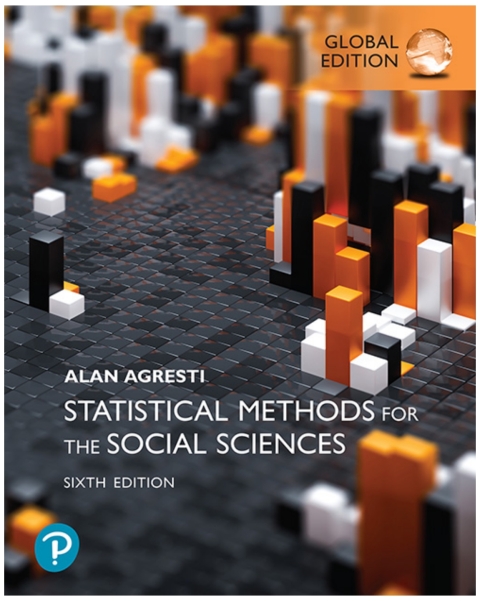Description
Efnisyfirlit
- Title Page
- Copyright Page
- Dedication
- Contents
- Preface
- Acknowledgments
- Chapter 1. Introduction
- 1.1 Introduction to Statistical Methodology
- 1.2 Descriptive Statistics and Inferential Statistics
- 1.3 The Role of Computers and Software in Statistics
- 1.4 Chapter Summary
- Exercises
- Chapter 2. Sampling and Measurement
- 2.1 Variables and Their Measurement
- 2.2 Randomization
- 2.3 Sampling Variability and Potential Bias
- 2.4 Other Probability Sampling Methods*
- 2.5 Chapter Summary
- Exercises
- Chapter 3. Descriptive Statistics
- 3.1 Describing Data with Tables and Graphs
- 3.2 Describing the Center of the Data
- 3.3 Describing Variability of the Data
- 3.4 Measures of Position
- 3.5 Bivariate Descriptive Statistics
- 3.6 Sample Statistics and Population Parameters
- 3.7 Chapter Summary
- Exercises
- Chapter 4. Probability Distributions
- 4.1 Introduction to Probability
- 4.2 Probability Distributions for Discrete and Continuous Variables
- 4.3 The Normal Probability Distribution
- 4.4 Sampling Distributions Describe How Statistics Vary
- 4.5 Sampling Distributions of Sample Means
- 4.6 Review: Population, Sample Data, and Sampling Distributions
- 4.7 Chapter Summary
- Exercises
- Chapter 5. Statistical Inference: Estimation
- 5.1 Point and Interval Estimation
- 5.2 Confidence Interval for a Proportion
- 5.3 Confidence Interval for a Mean
- 5.4 Choice of Sample Size
- 5.5 Estimation Methods: Maximum Likelihood and the Bootstrap*
- 5.6 Chapter Summary
- Exercises
- Chapter 6. Statistical Inference: Significance Tests
- 6.1 The Five Parts of a Significance Test
- 6.2 Significance Test for a Mean
- 6.3 Significance Test for a Proportion
- 6.4 Decisions and Types of Errors in Tests
- 6.5 Limitations of Significance Tests
- 6.6 Finding P(Type II Error)
- 6.7 Small-Sample Test for a Proportion—The Binomial Distribution*
- 6.8 Chapter Summary
- Exercises
- Chapter 7. Comparison of Two Groups
- 7.1 Preliminaries for Comparing Groups
- 7.2 Categorical Data: Comparing Two Proportions
- 7.3 Quantitative Data: Comparing Two Means
- 7.4 Comparing Means with Dependent Samples
- 7.5 Other Methods for Comparing Means*
- 7.6 Other Methods for Comparing Proportions*
- 7.7 Nonparametric Statistics for Comparing Groups*
- 7.8 Chapter Summary
- Exercises
- Chapter 8. Analyzing Association Between Categorical Variables
- 8.1 Contingency Tables
- 8.2 Chi-Squared Test of Independence
- 8.3 Residuals: Detecting the Pattern of Association
- 8.4 Measuring Association in Contingency Tables
- 8.5 Association Between Ordinal Variables*
- 8.6 Chapter Summary
- Exercises
- Chapter 9. Linear Regression and Correlation
- 9.1 Linear Relationships
- 9.2 Least Squares Prediction Equation
- 9.3 The Linear Regression Model
- 9.4 Measuring Linear Association: The Correlation
- 9.5 Inferences for the Slope and Correlation
- 9.6 Model Assumptions and Violations
- 9.7 Chapter Summary
- Exercises
- Chapter 10. Introduction to Multivariate Relationships
- 10.1 Association and Causality
- 10.2 Controlling for Other Variables
- 10.3 Types of Multivariate Relationships
- 10.4 Inferential Issues in Statistical Control
- 10.5 Chapter Summary
- Exercises
- Chapter 11. Multiple Regression and Correlation
- 11.1 The Multiple Regression Model
- 11.2 Multiple Correlation and R2
- 11.3 Inferences for Multiple Regression Coefficients
- 11.4 Modeling Interaction Effects
- 11.5 Comparing Regression Models
- 11.6 Partial Correlation*
- 11.7 Standardized Regression Coefficients*
- 11.8 Chapter Summary
- Exercises
- Chapter 12. Regression with Categorical Predictors: Analysis of Variance Methods
- 12.1 Regression Modeling with Dummy Variables for Categories
- 12.2 Multiple Comparisons of Means
- 12.3 Comparing Several Means: Analysis of Variance
- 12.4 Two-Way ANOVA and Regression Modeling
- 12.5 Repeated-Measures Analysis of Variance*
- 12.6 Two-Way ANOVA with Repeated Measures on a Factor*
- 12.7 Chapter Summary
- Exercises
- Chapter 13. Multiple Regression with Quantitative and Categorical Predictors
- 13.1 Models with Quantitative and Categorical Explanatory Variables
- 13.2 Inference for Regression with Quantitative and Categorical Predictors
- 13.3 Case Studies: Using Multiple Regression in Research
- 13.4 Adjusted Means*
- 13.5 The Linear Mixed Model*
- 13.6 Chapter Summary
- Exercises
- Chapter 14. Model Building with Multiple Regression
- 14.1 Model Selection Procedures
- 14.2 Regression Diagnostics
- 14.3 Effects of Multicollinearity
- 14.4 Generalized Linear Models
- 14.5 Nonlinear Relationships: Polynomial Regression
- 14.6 Exponential Regression and Log Transforms*
- 14.7 Robust Variances and Nonparametric Regression*
- 14.8 Chapter Summary
- Exercises
- Chapter 15. Logistic Regression: Modeling Categorical Responses
- 15.1 Logistic Regression
- 15.2 Multiple Logistic Regression
- 15.3 Inference for Logistic Regression Models
- 15.4 Logistic Regression Models for Ordinal Variables*
- 15.5 Logistic Models for Nominal Responses*
- 15.6 Loglinear Models for Categorical Variables*
- 15.7 Model Goodness-of-Fit Tests for Contingency Tables*
- 15.8 Chapter Summary
- Exercises
- Chapter 16. An Introduction to Advanced Methodology
- 16.1 Missing Data: Adjustment Using Multiple Imputation*
- 16.2 Multilevel (Hierarchical) Models*
- 16.3 Event History Models*
- 16.4 Path Analysis*
- 16.5 Factor Analysis*
- 16.6 Structural Equation Models*
- 16.7 Markov Chains*
- 16.8 The Bayesian Approach to Statistical Inference*
- Exercises
- Appendix: R, Stata, SPSS, and SAS for Statistical Analyses
- Bibliography
- Credits
- Index
- A
- B
- C
- D
- E
- F
- G
- H
- I
- J
- K
- L
- M
- N
- O
- P
- Q
- R
- S
- T
- U
- V
- W
- Y
- Z
- Key Formulas for Statistical Methods
- Table A: Normal curve tail probabilities. Standard normal probability in right-hand tail (for negati
- Table B: t Distribution Critical Values
- A Guide to Choosing a Statistical Method






Reviews
There are no reviews yet.